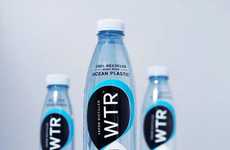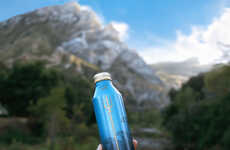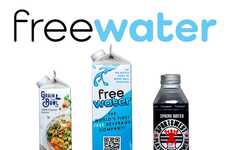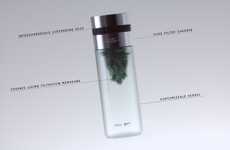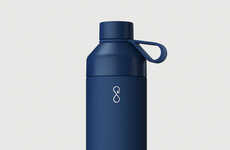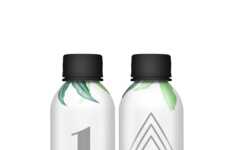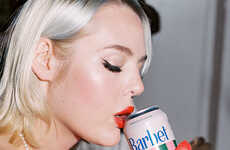
For Each Bottle Sold They Give Clean H2O to Haiti
Bianca — January 21, 2012 — Social Good
References: 1for1water
1for1 Water is a for-profit social enterprise that gives clean water to someone in Haiti each time you buy a bottle of 1for1. Worried that selling thousands of bottles would create more garbage and harm the environment, Matt Keller and Brett Trapp created bottles for recyclable, biodegradable materials.
We had a chance to interview Matt on the triple bottom line business he started with his partner. In the answers below he shares where the idea for the social business came from, where he gets his inspiration, and his secrets to getting into the creative zone.
4 Questions with Matt Keller, Co-Founder of 1for1 Water
1. How did the idea for the business model come about?
I was at the 2010 Sundance Film Festival right after the quake in Haiti. One evening, I ended up brainstorming with a group of friends around ways to raise money for the relief efforts. Seeing how temporary the efforts were, we started talking about a sustainable concept of aid funded by everyday purchases. Shortly after that, I reached out to a friend in the bottled water industry, and we discovered it would be a great category to test our theory that, if given the option, people would rally around doing good with their everyday purchases.
2. How did you decide to join this sector?
I don't know if someone ever really decides to view themselves as a "social entrepreneur" or join the sector. It is either in you or it's not. If you love people and want to change the world for the better and that drives your entrepreneurial ventures, then it's who you are. The trick is to balance out the two responsibilities you have as a business owner: To do good and be profitable. Some people will elevate one and minimize the other, but you have to value both. Good intentions without good business just make for bad business with nothing to show for it. For me, profitability serves my passion and the organization's goal of doing good, not the other way around.
3. How do you get your inspiration?
I read a lot and explore random ideas and concepts. To me it's a balance of old classics that inspire my soul and innovative blogs and magazines that challenge my mind. I just finished a G.K Chesterton book called Manalive, and it kicked me in the pants to get more life out of my days.
4. How do you reset yourself to be creative? Do you have any rituals?
Pet projects really help me. Thinking through how I am going to put a trap door in my kitchen that leads down to the bomb shelter so I can use it as a wine cellar helps me be more creative in business, because it's a ridiculous and unconventional thing to do. Thus, I feel more free and out of the box already. My pet projects tend to be around the house, so Pinterest helps, but don't tell anyone I confessed that.
We had a chance to interview Matt on the triple bottom line business he started with his partner. In the answers below he shares where the idea for the social business came from, where he gets his inspiration, and his secrets to getting into the creative zone.
4 Questions with Matt Keller, Co-Founder of 1for1 Water
1. How did the idea for the business model come about?
I was at the 2010 Sundance Film Festival right after the quake in Haiti. One evening, I ended up brainstorming with a group of friends around ways to raise money for the relief efforts. Seeing how temporary the efforts were, we started talking about a sustainable concept of aid funded by everyday purchases. Shortly after that, I reached out to a friend in the bottled water industry, and we discovered it would be a great category to test our theory that, if given the option, people would rally around doing good with their everyday purchases.
2. How did you decide to join this sector?
I don't know if someone ever really decides to view themselves as a "social entrepreneur" or join the sector. It is either in you or it's not. If you love people and want to change the world for the better and that drives your entrepreneurial ventures, then it's who you are. The trick is to balance out the two responsibilities you have as a business owner: To do good and be profitable. Some people will elevate one and minimize the other, but you have to value both. Good intentions without good business just make for bad business with nothing to show for it. For me, profitability serves my passion and the organization's goal of doing good, not the other way around.
3. How do you get your inspiration?
I read a lot and explore random ideas and concepts. To me it's a balance of old classics that inspire my soul and innovative blogs and magazines that challenge my mind. I just finished a G.K Chesterton book called Manalive, and it kicked me in the pants to get more life out of my days.
4. How do you reset yourself to be creative? Do you have any rituals?
Pet projects really help me. Thinking through how I am going to put a trap door in my kitchen that leads down to the bomb shelter so I can use it as a wine cellar helps me be more creative in business, because it's a ridiculous and unconventional thing to do. Thus, I feel more free and out of the box already. My pet projects tend to be around the house, so Pinterest helps, but don't tell anyone I confessed that.
Trend Themes
1. Sustainable Social Enterprises - Creating business models that combine profitability with social impact by leveraging everyday purchases.
2. Recyclable and Biodegradable Materials - Using environmentally friendly materials for product packaging and reducing waste.
3. Balancing Profitability and Social Impact - Finding ways to prioritize and value both business profitability and social good in entrepreneurial ventures.
Industry Implications
1. Social Enterprise - Exploring opportunities to start profitable businesses that address social and environmental issues.
2. Bottled Water Industry - Reimagining the bottled water industry to incorporate sustainable and socially responsible practices.
3. Alternative Packaging Solutions - Developing and promoting recyclable and biodegradable materials as alternatives to traditional packaging.
4.4
Score
Popularity
Activity
Freshness


